Satavian guilder: Difference between revisions
No edit summary |
m (→History) |
||
| (5 intermediate revisions by the same user not shown) | |||
| Line 71: | Line 71: | ||
The '''Satavian guilder''' ({{wpl|Afrikaans|Asteriaans}}:'' Satawiese gulden'', {{wpl|Dutch language|Hennish}}: ''Satavisch gulden''; {{wpl|currency sign|sign}} '''G'''; {{wpl|ISO 4217|code}}: '''SVG''') is the official currency of [[Satavia]], and is {{wpl|legal tender}} in [[Naua Roa]]. | The '''Satavian guilder''' ({{wpl|Afrikaans|Asteriaans}}:'' Satawiese gulden'', {{wpl|Dutch language|Hennish}}: ''Satavisch gulden''; {{wpl|currency sign|sign}} '''G'''; {{wpl|ISO 4217|code}}: '''SVG''') is the official currency of [[Satavia]], and is {{wpl|legal tender}} in [[Naua Roa]]. | ||
Introduced in 1943, the Guilder replaced the [[Satavian shilling]] and is subdivided into 100 cents. The guilder has 8 coins and 5 banknotes, with the smallest being the [[Satavian guilder#Coins|1-cent coin]], which together with the [[Satavian guilder#Coins|2-cent coin]] are still minted, although rarely used. | Introduced in 1943, the Guilder replaced the [[Satavian shilling]] and is subdivided into 100 cents. The guilder has 8 coins and 5 banknotes, with the smallest denomination being the [[Satavian guilder#Coins|1-cent coin]], which together with the [[Satavian guilder#Coins|2-cent coin]] are still minted, although rarely used. | ||
==History== | ==History== | ||
The Satavian guilder was introduced on January 1, 1943 as the {{wpl|decimalised}} replacement to the [[Satavian shilling]]. The shilling had utilised the {{wpl|£sd}} system, as was common in former colonies and territories of [[Estmere]], which by 1943 was regarded as complicated and obsolete. The Satavian shilling remained legal tender in Satavia until January 1, 1946. The shilling was introduced by the [[National party (Satavia)|National party]] government of [[Christiaan Pienaar]]. The National party had launched a coup in February 1939 that had removed the democratically elected government of [[Edward Limes]], and as part of the new government's programme of 'decolonisation' (Satavia had only achieved independence from Estmere in 1936) the shilling was decimalised. The currency was renamed the Guilder (as it had been before Estmere seized control of Satavia in 1747) and was initially pegged to the [[Estmerish shilling]] at par, before it was devalued in 1959 to Sh1 = G1.5 and was again devalued in 1968 to Sh1 = G2.5. The guilder was floated in 1978, as part of the [[Liberal party (Satavia)|Liberal]] government's 'post- | The Satavian guilder was introduced on January 1, 1943 as the {{wpl|decimalised}} replacement to the [[Satavian shilling]]. The shilling had utilised the {{wpl|£sd}} system, as was common in former colonies and territories of [[Estmere]], which by 1943 was regarded as complicated and obsolete. The Satavian shilling remained legal tender in Satavia until January 1, 1946. The shilling was introduced by the [[National party (Satavia)|National party]] government of [[Christiaan Pienaar]]. The National party had launched a coup in February 1939 that had removed the democratically elected government of [[Edward Limes]], and as part of the new government's programme of 'decolonisation' (Satavia had only achieved independence from Estmere in 1936) the shilling was decimalised. The currency was renamed the Guilder (as it had been before Estmere seized control of Satavia in 1747) and was initially pegged to the [[Estmerish shilling]] at par, before it was devalued in 1959 to Sh1 = G1.5 and was again devalued in 1968 to Sh1 = G2.5. The guilder was floated in 1978, as part of the [[Liberal party (Satavia)|Liberal]] government's 'post-dictatorship recovery plan'. During the [[financial crisis of 2005]], the [[Reserve Bank of Satavia]] sold an undisclosed amount of Satavian guilders in an unsuccessful attempt to drive down the guilders' value. In June 2008, the Reserve Bank began purchasing {{wpl|government bonds}} and a large selection of other {{wpl|financial assets}} in an attempt to increase inflation, which had begun rapidly decreasing at the start of the year. The intervention is one of the only successful instances of {{wpl|quantitive easing}}. | ||
As of July 2022, the SVG was trading at approximately €0.12. | As of July 2022, the SVG was trading at approximately €0.12. | ||
| Line 80: | Line 80: | ||
==Coins== | ==Coins== | ||
===History=== | ===History=== | ||
Upon the introduction of the guilder, coins came in the denominations 1c, 2c, 5c, 10c, 20c, 50c. The 1c and 2c coins were copper, whilst the 5c, 10c, 20c and 50c coins were an alloy of silver and copper. All the coins featured the [[Coat of arms of the Republic of Satavia|coat of arms of the Republic of Satavia]] on the obverse (replacing the head of a monarch which had previously been used on the shilling until 1936) whilst they often featured National party politicians on the reverse (such as [[Christiaan Pienaar]] who was featured on the 50c coin from 1947 until 1976). The only exception to this rule was the 10c, 20c and 50c coins minted in 1966, the 425th | Upon the introduction of the guilder, coins came in the denominations 1c, 2c, 5c, 10c, 20c, 50c. The 1c and 2c coins were copper, whilst the 5c, 10c, 20c and 50c coins were an alloy of silver and copper. All the coins featured the [[Coat of arms of the Republic of Satavia|coat of arms of the Republic of Satavia]] on the obverse (replacing the head of a monarch which had previously been used on the shilling until 1936) whilst they often featured National party politicians on the reverse (such as [[Christiaan Pienaar]] who was featured on the 50c coin from 1947 until 1976). The only exception to this rule was the 10c, 20c and 50c coins minted in 1966, the 425th anniversary of the landings of [[Jan van Breybach]] at [[Port Hope|Sandy Cove]], where the obverse featured a variety of [[Hennehouwe|Hennish]] and {{wpl|Afrikaner|Asterianer}} symbols and emblems, whilst the reverse depicted [[Adriaan Pienaar]], [[Jan van Breybach]] and [[Christiaan Matthys]]. | ||
Coins minted from 1976 feature the [[Coat of arms of Satavia|coat of arms of Satavia]] on the reverse and a variety of different depictions of Satavia on the obverse, that have included {{wpl|fauna}}, {{wpl|flora}}, {{wpl|architecture}} and various 'great Satavians'. The 1c and 2c | Coins minted from 1976 feature the [[Coat of arms of Satavia|coat of arms of Satavia]] on the reverse and a variety of different depictions of Satavia on the obverse, that have included {{wpl|fauna}}, {{wpl|flora}}, {{wpl|architecture}} and various 'great Satavians'. The 1c and 2c coins have continued to be minted but are rarely used, and proposals to demonetise the coins have been discussed since as early as 1995. | ||
On 27 September 2001, the Reserve Bank issued | On 27 September 2001, the Reserve Bank issued its first commemorative coins that would celebrate 25 years of restored democracy in Satavia. One million coins, of the 20c denomination, were minted. | ||
On 1 January 2004, the Reserve Bank issued a second group of commemorative coins that would honour the life of Johan van Vallier, who had died 100 years prior. A further one million coins, of the 50c denomination, were minted. | On 1 January 2004, the Reserve Bank issued a second group of commemorative coins that would honour the life of Johan van Vallier, who had died 100 years prior. A further one million coins, of the 50c denomination, were minted. | ||
On 1 October 2016, the Reserve Bank issued | On 1 October 2016, the Reserve Bank issued its third and to date latest batch of commemorative coins that marked two hundred years since the [[Satavia|Federation of Satavia]] that lead to dominion status. | ||
===Current circulating coins=== | ===Current circulating coins=== | ||
| Line 194: | Line 194: | ||
The [[Satavian guilder#Banknotes|G1]] and [[Satavian guilder#Banknotes|G2]] banknotes were withdrawn from circulation in 1979, whilst the [[Satavian guilder#Banknotes|G1000]] note was demonetised in 1997. | The [[Satavian guilder#Banknotes|G1]] and [[Satavian guilder#Banknotes|G2]] banknotes were withdrawn from circulation in 1979, whilst the [[Satavian guilder#Banknotes|G1000]] note was demonetised in 1997. | ||
Series E notes were introduced in 2004, and Series F notes were introduced in 2022. The Series F notes proved controversial as the Reserve Bank moved away from the classic design and towards a "modern, sleek design". The banknotes have been described as looking "more like an advert" or a "museum banner". The notes' reverse also proved controversial, with the "great Satavians" featured including [[Johan van Vallier]], whose critical role in the [[Great Shame]] has been uncovered in recent years, as well as [[Richard Hope, Earl of Longwood]] who was born in Satavia (both the [[Hope Province]] and [[Port Hope]] are named for him) but served as [[Prime Minister of Estmere]]. Furthermore, the phrase "{{wpl|I promise to pay the bearer on demand the sum...}}" was removed from the Series F notes, marking the first time since currency was standardised across Satavia that banknotes have not featured the phrase. | Series E notes were introduced in 2004, and Series F notes were introduced in 2022. The Series F notes proved controversial as the Reserve Bank moved away from the classic design and towards a "modern, sleek design". The banknotes have been described as looking "more like an advert" or a "museum banner". The notes' reverse also proved controversial, with the "great Satavians" featured including [[Johan van Vallier]], whose critical role in the [[Great Shame]] has been uncovered in recent years, as well as [[Richard Hope, Earl of Longwood]] who was born in Satavia (both the [[Hope Province]] and [[Port Hope]] are named for him) but served as [[Prime Minister of Estmere]]. Furthermore, the phrase "{{wpl|Promissory note|I promise to pay the bearer on demand the sum...}}" was removed from the Series F notes, marking the first time since currency was standardised across Satavia that banknotes have not featured the phrase. | ||
{| class="wikitable" style="font-size: 90%" data-ve-attributes="{"style":"font-size: 90%"}" | {| class="wikitable" style="font-size: 90%" data-ve-attributes="{"style":"font-size: 90%"}" | ||
| Line 214: | Line 214: | ||
|Red | |Red | ||
|[[Government House, Port Hope]] | |[[Government House, Port Hope]] | ||
|[[War of the Triple Alliance|Battle of | |[[War of the Triple Alliance|Battle of Trierberg]], [[Richard Hope, Earl of Longwood]] | ||
|- | |- | ||
|align="center"|[[File:10G - Obverse (PNG).png|300px]] | |align="center"|[[File:10G - Obverse (PNG).png|300px]] | ||
| Line 234: | Line 234: | ||
|'''[[Satavian guilder#Banknotes|G50]]''' | |'''[[Satavian guilder#Banknotes|G50]]''' | ||
|Green | |Green | ||
|[[ | |[[Port Hope Opera House]], [[Port Hope|Sandy Cove Bridge]] | ||
|[[Edward Limes]], Edward Limes lying in State | |[[Edward Limes]], Edward Limes lying in State | ||
|- | |- | ||
| Line 253: | Line 253: | ||
[[Category:Circulating currencies]] | [[Category:Circulating currencies]] | ||
[[Category:ISO 4217]] | [[Category:ISO 4217]] | ||
[[Category:Satavia]] | [[Category:Economy of Satavia]] | ||
Latest revision as of 19:32, 12 November 2023
| Asteriaans: Satawiese gulden Hennish: Satavisch gulden | |||||
|---|---|---|---|---|---|
| |||||
| ISO 4217 | |||||
| Unit | |||||
| Symbol | G | ||||
| Denominations | |||||
| Subunit | |||||
| 1:100 | cent | ||||
| Symbol | |||||
| cent | c | ||||
| Banknotes | |||||
| Freq. used | G5, G10, G20, G50, G100 | ||||
| Rarely used | No longer in use: G1, G2 | ||||
| Coins | |||||
| Freq. used | 5c, 10c, 20c, 50c, G1, G2 | ||||
| Rarely used | 1c, 2c | ||||
| Demographics | |||||
| Date of introduction | January 1, 1943 | ||||
| Replaced | Satavian shilling | ||||
| User(s) | |||||
| Issuance | |||||
| Central bank | Reserve Bank of Satavia | ||||
| Website | rbs | ||||
| Printer | Federal Printing Office | ||||
| Mint | Estmerish Mint | ||||
| Website | mint | ||||
| Valuation | |||||
| Inflation | 3.4% | ||||
The Satavian guilder (Asteriaans: Satawiese gulden, Hennish: Satavisch gulden; sign G; code: SVG) is the official currency of Satavia, and is legal tender in Naua Roa.
Introduced in 1943, the Guilder replaced the Satavian shilling and is subdivided into 100 cents. The guilder has 8 coins and 5 banknotes, with the smallest denomination being the 1-cent coin, which together with the 2-cent coin are still minted, although rarely used.
History
The Satavian guilder was introduced on January 1, 1943 as the decimalised replacement to the Satavian shilling. The shilling had utilised the £sd system, as was common in former colonies and territories of Estmere, which by 1943 was regarded as complicated and obsolete. The Satavian shilling remained legal tender in Satavia until January 1, 1946. The shilling was introduced by the National party government of Christiaan Pienaar. The National party had launched a coup in February 1939 that had removed the democratically elected government of Edward Limes, and as part of the new government's programme of 'decolonisation' (Satavia had only achieved independence from Estmere in 1936) the shilling was decimalised. The currency was renamed the Guilder (as it had been before Estmere seized control of Satavia in 1747) and was initially pegged to the Estmerish shilling at par, before it was devalued in 1959 to Sh1 = G1.5 and was again devalued in 1968 to Sh1 = G2.5. The guilder was floated in 1978, as part of the Liberal government's 'post-dictatorship recovery plan'. During the financial crisis of 2005, the Reserve Bank of Satavia sold an undisclosed amount of Satavian guilders in an unsuccessful attempt to drive down the guilders' value. In June 2008, the Reserve Bank began purchasing government bonds and a large selection of other financial assets in an attempt to increase inflation, which had begun rapidly decreasing at the start of the year. The intervention is one of the only successful instances of quantitive easing.
As of July 2022, the SVG was trading at approximately €0.12.
Coins
History
Upon the introduction of the guilder, coins came in the denominations 1c, 2c, 5c, 10c, 20c, 50c. The 1c and 2c coins were copper, whilst the 5c, 10c, 20c and 50c coins were an alloy of silver and copper. All the coins featured the coat of arms of the Republic of Satavia on the obverse (replacing the head of a monarch which had previously been used on the shilling until 1936) whilst they often featured National party politicians on the reverse (such as Christiaan Pienaar who was featured on the 50c coin from 1947 until 1976). The only exception to this rule was the 10c, 20c and 50c coins minted in 1966, the 425th anniversary of the landings of Jan van Breybach at Sandy Cove, where the obverse featured a variety of Hennish and Asterianer symbols and emblems, whilst the reverse depicted Adriaan Pienaar, Jan van Breybach and Christiaan Matthys.
Coins minted from 1976 feature the coat of arms of Satavia on the reverse and a variety of different depictions of Satavia on the obverse, that have included fauna, flora, architecture and various 'great Satavians'. The 1c and 2c coins have continued to be minted but are rarely used, and proposals to demonetise the coins have been discussed since as early as 1995.
On 27 September 2001, the Reserve Bank issued its first commemorative coins that would celebrate 25 years of restored democracy in Satavia. One million coins, of the 20c denomination, were minted.
On 1 January 2004, the Reserve Bank issued a second group of commemorative coins that would honour the life of Johan van Vallier, who had died 100 years prior. A further one million coins, of the 50c denomination, were minted.
On 1 October 2016, the Reserve Bank issued its third and to date latest batch of commemorative coins that marked two hundred years since the Federation of Satavia that lead to dominion status.
Current circulating coins
| Denomination | Coin | Obverse | Reverse | Diameter | Thickness | Mass | Composition | Edge | Introduced | Issued (series) | |
|---|---|---|---|---|---|---|---|---|---|---|---|
| 1c |  
|
Coat of arms of Satavia | Jaguar accompanied by the year of minting and denomination. | 21.4 mm | 1.7 mm | 3.70 g | Cupronickel-plated steel | Smooth, Reuleaux heptagon | 1999 | 2021 | |
| 2c |  
|
Rhea accompanied by the year of minting and denomination | 25.9 mm | 1.87 mm | 7.12 g | ||||||
| 5c |  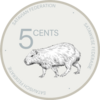
|
Three Hope River dolphins extracted from the coat of arms of Satavia | Capybara accompanied by the year of minting and denomination. | 24.5 mm | 2.05 mm | 6.5 g | Milled | 2005 | 2020 | ||
| 10c |  
|
Guanaco accompanied by the year of minting and denomination | 7.11 g | ||||||||
| 20c |  
|
Spider Monkey accompanied by the year of minting and denomination | 25.3 mm | 2.15 mm | 7.12 g | ||||||
| 50c |  
|
Two Hope River dolphins | Harpy eagle accompanied by the year of minting and denomination. | 27.3 mm | 1.78 mm | 8 g | Cupronickel-plated steel (3:1) | Smooth | 2016 | ||
| G1 |  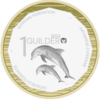
|
Three Hope River dolphins extracted from the coat of arms of Satavia | Two Hope River dolphins accompanied by the year of minting, denomination and coat of arms of Satavia. | 23.43 mm | 2.8 mm | 8.75 g | Inner: Cupronickel Outer: Nickel-brass |
Milled with inscription "I Vow To Thee, My Country", although some minted with the Solarian inscription "condemnant quod non intellegunt" meaning "they condemn because they do not understand" | 2011 | 2018 | |
| G2 |  
|
Coat of arms of Satavia, accompanied by the year of minting and denomination. | 28.4 mm | 2.5 mm | 12 g | Inner:Nickel-plated alloy Outer: Nickel-brass |
Milled with inscription "I promise to pay the bearer on demand the sum of two guilders" | 2019 | |||
Banknotes
History
Banknotes for the Satavian guilder were issued in 1943 with the denomination of G1, G2, G5, G10, G20, G100 and G1000. The original series of notes featured a portrait of Oscar Harrision, the former leader of the National party who had been assassinated in 1941, as well as images of Satavian flora and fauna, whilst the reverse showed images of Satavian landscapes.
The G1 and G2 banknotes were withdrawn from circulation in 1979, whilst the G1000 note was demonetised in 1997.
Series E notes were introduced in 2004, and Series F notes were introduced in 2022. The Series F notes proved controversial as the Reserve Bank moved away from the classic design and towards a "modern, sleek design". The banknotes have been described as looking "more like an advert" or a "museum banner". The notes' reverse also proved controversial, with the "great Satavians" featured including Johan van Vallier, whose critical role in the Great Shame has been uncovered in recent years, as well as Richard Hope, Earl of Longwood who was born in Satavia (both the Hope Province and Port Hope are named for him) but served as Prime Minister of Estmere. Furthermore, the phrase "I promise to pay the bearer on demand the sum..." was removed from the Series F notes, marking the first time since currency was standardised across Satavia that banknotes have not featured the phrase.
| Current Series | |||||
|---|---|---|---|---|---|
| Image | Value | Main Colour | Description | ||
| Obverse | Reverse | Obverse | Reverse | ||

|
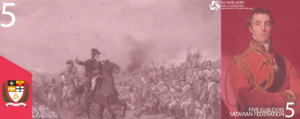
|
G5 | Red | Government House, Port Hope | Battle of Trierberg, Richard Hope, Earl of Longwood |
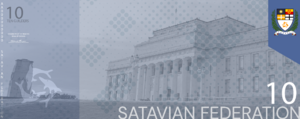
|
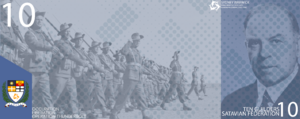
|
G10 | Blue | National War Museum | Satavian troops during the Great War, Sydney Warwick |
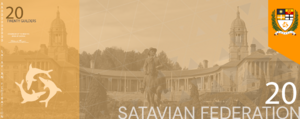
|
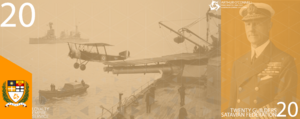
|
G20 | Orange | Parliament Buildings, Sandy Cove | HMSS Satavia, Arthur O'Connell |
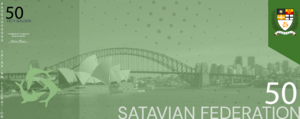
|
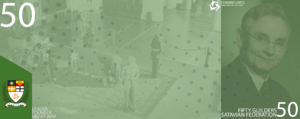
|
G50 | Green | Port Hope Opera House, Sandy Cove Bridge | Edward Limes, Edward Limes lying in State |

|
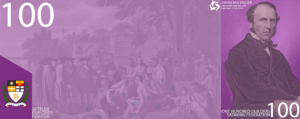
|
G100 | Purple | Hope House, Burnaby | Jan Vijoen's "Meeting with the natives" (1844), Johan van Vallier |
